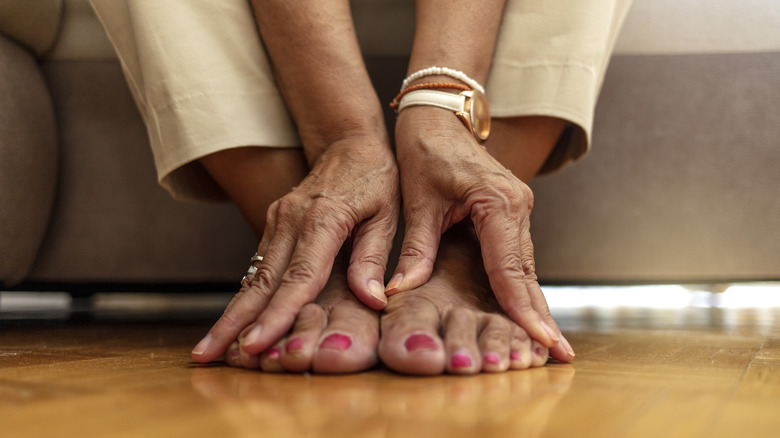What Happens When You Have Diabetic Foot Ulcers?
Diabetes is much more than the result of drinking too much sugary soda. While diet can contribute to diabetes, the disease can also be related to genetics, ethnicity, and age (per American Heart Association). Regardless of the cause, there's no known cure for diabetes, according to WebMD. However, people who are diagnosed with the condition can take steps to manage their symptoms.
Symptoms vary based on the type of diabetes. The Centers for Disease Control and Prevention explains that symptoms of type 1 diabetes can be severe and may appear over a short amount of time. By contrast, the signs of type 2 diabetes are often less obvious and may go undetected for years. In either case, common symptoms can include frequent urination, persistent thirst and hunger, blurry vision, fatigue, weight loss, and sores or dry skin. People with diabetes may also notice they experience more infections than usual.
Additionally, diabetes can lead to a lesser-known but potentially dangerous symptom: foot ulcers. According to the University of Michigan Health, around 15% of people with diabetes will develop ulcers on their feet. If left untreated, these sores can result in serious complications.
Diabetic foot ulcers are serious but preventable
Ulcers are a warning sign from your feet worth paying attention to. According to Healthline, diabetic foot ulcers can be identified by symptoms such as pain, drainage, swelling, redness, and discolored (often blackened) tissue. These lesions are caused by poor circulation, nerve damage, and hyperglycemia — complications of unmanaged diabetes. However, anyone with diabetes can develop foot ulcers.
Diabetic foot ulcers may take weeks or even months to heal, per MedlinePlus. Treatment often involves removing dead skin and tissue around the ulcer and may require hospitalization. It's also important to take care of the affected foot by wearing special shoes and using crutches or a wheelchair to avoid putting pressure on the ulcer.
If ulcers aren't treated, they may lead to amputation. In fact, the University of Michigan Health estimates that between 14% and 24% of patients with diabetes who develop a foot ulcer will require amputation.
Proper treatment and prevention are key to avoiding these risks. People with diabetes should contact a medical professional immediately if they notice signs of an ulcer on the foot. Some people who are especially at risk — such as those with neuropathy, poor circulation, or uncontrolled blood sugar — should visit a podiatrist regularly to prevent ulcers from forming.
Everyday lifestyle habits can also have a powerful impact on preventing ulcers. Wearing doctor-approved shoes, cutting out alcohol and tobacco, and stabilizing blood sugar levels are important steps in keeping your feet — and your body in general — healthy.


